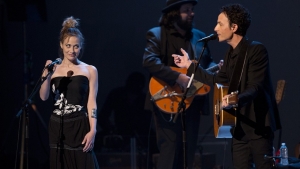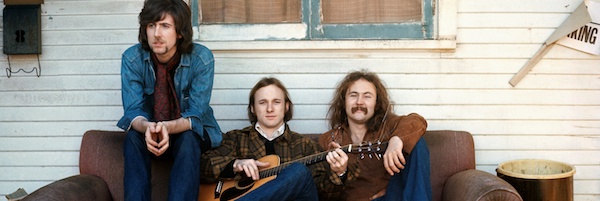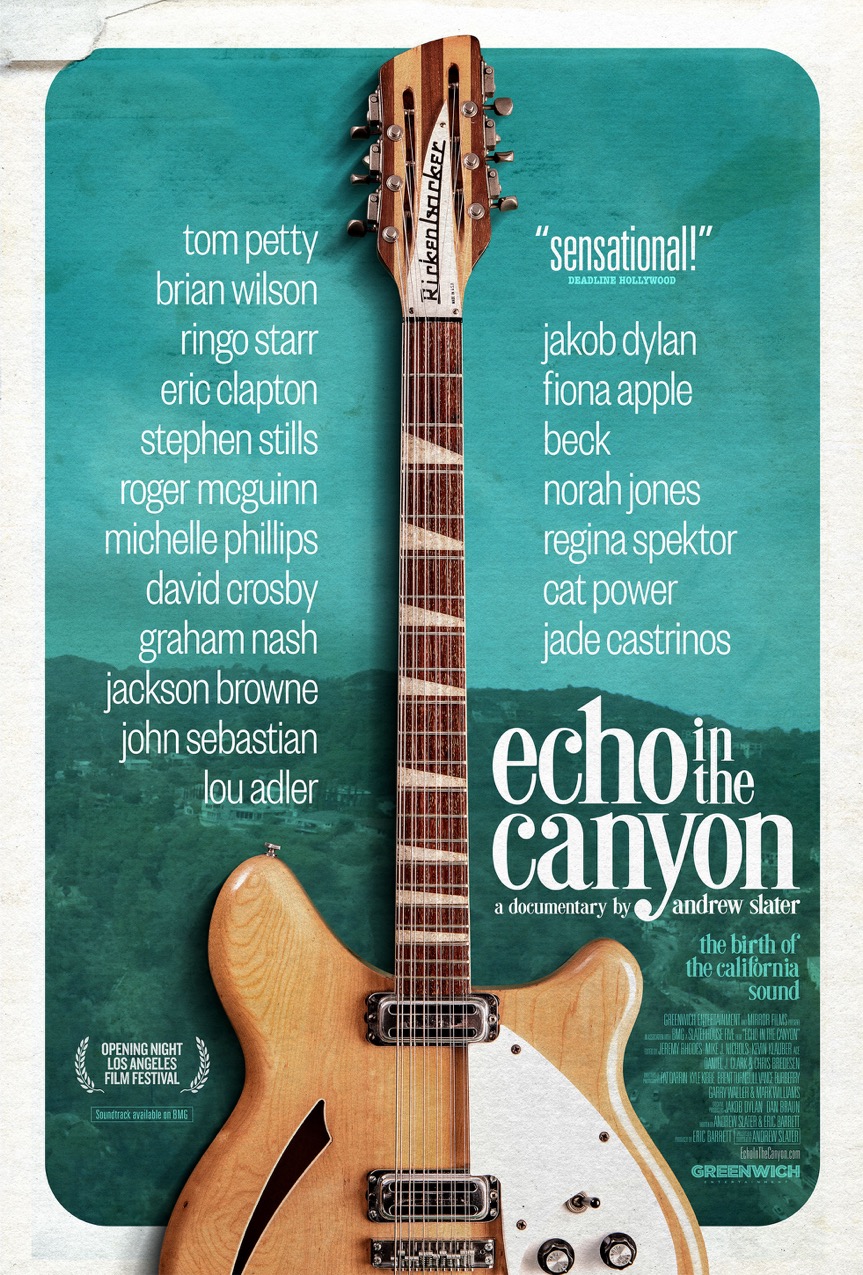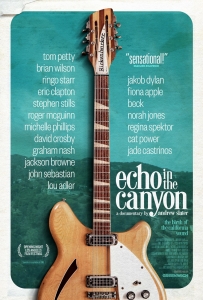Echo in the Canyon
As a ‘60s rock exceptionalist, I’m a sucker for a flick like this. I’ve always believed the songs of that era are unequaled in rock/pop history.
Granted, I swooned over the early rock & roll of the 50s. (I had to stay home “sick” for months of elementary school to make sure I didn’t miss the first 30 minutes of American Bandstand.)
But R&R suffered a quick demise in 1959, as later commemorated in the Don McLean song, “The Day the Music Died.” Fortunately, five years later The Beatles reinvented rock, and I became a born-again believer. 18 months after that the folk-rockers did a lyrical upgrade to it, and I became a lifer.
In the summer of 1965—thanks in large part to Bob Dylan and The Byrds (“Like a Rolling Stone” and “Mr. Tambourine Man”)—this primitive musical form was becoming a vehicle for art and poetry. Rock was quickly growing up, just as you and I were entering Yale in September of freshman year. It felt like we were all heading into adulthood together. In fact, it felt like The Beatles and Byrds were off to college with us.
That fall and winter WYBC offered us a banquet of lyrically and harmonically rich songs to relish—“Turn! Turn! Turn!” by The Byrds, “Norwegian Wood” by The Beatles, even “California Dreamin’” by The Mamas and Papas, to name a few. And that was just the beginning. But instead of simply enjoying these tunes, many of us became rock & roll analysts, deconstructing our favorite singles and albums as if we were exegetes interpreting sacred texts. Such was the power and poetry of that music, especially what was coming out of Los Angeles.
Echo in the Canyon is an 82-minute rock doc that traces the music of this period—1965 to 1967—through the songs of The Byrds, Buffalo Springfield, Beach Boys, and Mamas and Papas. These pop pioneers lived, hung out, and swapped songs (and occasionally lovers) in the Hollywood Hills in a woodsy region known as Laurel Canyon. It quickly became an innovation nexus that changed music forever.
To broaden demographic appeal for the movie, Jakob (son of Bob) Dylan appeared as screen host who performed duets of the classic songs with younger pop luminaries such as Beck, Fiona Apple, Jade, Regina Spektor, Cat Power, and Norah Jones.
Dylan also conducted short interviews with the original artists as well as music celebs who were admirers of the scene: Tom Petty, Eric Clapton, Ringo Starr, Jackson Browne, John Sebastian, Brian Wilson, Stephen Stills, David Crosby, Michelle Phillips, Graham Nash, and record producer Lou Adler.
I was hooked from the start, beginning with the opening chords of “Turn! Turn! Turn!” through “The Bells of Rhymney” and “Wild Mountain Thyme.” These Byrds’ classics played well against the sweeping aerial visuals of Laurel Canyon.
 Though I would have preferred to hear more of the original tracks, much of the footage of Dylan & Co’s performances worked for me—both the snippets of the live concert they put on at LA’s Orpheum Theater and the studio recordings they did for the soundtrack. One highlight was Fiona Apple joining Dylan to sing “It Won’t Be Wrong” (a Byrds’ B-side) and “In My Room” (a Beach Boys’ hit). The blatantly seductive looks that Apple gave Dylan on stage were worth multiple replays.
Though I would have preferred to hear more of the original tracks, much of the footage of Dylan & Co’s performances worked for me—both the snippets of the live concert they put on at LA’s Orpheum Theater and the studio recordings they did for the soundtrack. One highlight was Fiona Apple joining Dylan to sing “It Won’t Be Wrong” (a Byrds’ B-side) and “In My Room” (a Beach Boys’ hit). The blatantly seductive looks that Apple gave Dylan on stage were worth multiple replays.
Some highlights from Dylan’s interviews with the original rockers:
David Crosby: “We were putting good poetry on the radio—AM radio, pop radio—for the first time. There wasn’t any of that before. It was ‘June, moon, spoon, baby I love you, ooh ooh.’ It wasn’t ‘dance beneath the diamond sky with one hand waving free.’ It changed everything for everybody.”
Eric Clapton: “I loved it because I’ve always loved eccentricity. I’m attracted to eccentrics…they were all there [in the Canyon].”
Michelle Phillips: “It was all very romantic…[Affairs are] going to happen. The dynamics in a group when there are men and there are women. You see something in a band member—their talent, their sexiness, and there’s a spark…I was raised in a very free atmosphere…I was a busy girl and I was having a lot of fun.”
 Graham Nash (comparing the Canyon creativity to Vienna at the turn of the century and to Paris in the 30s): “This era in time is going to be treated exactly the same way in a couple hundred years by the historians. The power of music is undeniable. I truly believe it can change the world.”
Graham Nash (comparing the Canyon creativity to Vienna at the turn of the century and to Paris in the 30s): “This era in time is going to be treated exactly the same way in a couple hundred years by the historians. The power of music is undeniable. I truly believe it can change the world.”
It was only later that I realized who was missing from the movie: Joni Mitchell. (Perhaps she refused to participate?) There was also little mention of other Laurel Canyon notables such as Jimi Hendrix, Jim Morrison, Carole King. Or, ahem, Charles Manson. But I won’t quibble. A much longer documentary, Laurel Canyon, has recently come out—not yet available on Netflix—which covers more artists and a longer period.
If—as Tom Petty observed in the film—it was “the dreamers” who came to LA, that certainly fit the band I was in. Leaving academia in the dust in the spring of 1968, my Yale folk-rock group, The Morning, headed to California for love and fortune. We were soon “discovered” by Doug Weston, the owner of the Troubadour coffee house in West LA, while we were performing at the Berkeley Folk Festival with Joan Baez. He said if we could leave for Hollywood in our bus that night he would feature us as a guest artist at his club that week.
The following evening we were on stage at the Troubadour opening for The Nitty Gritty Dirt Band and Tom Rush. Judy Collins, in the audience that night, was lavish in her praise of us. (Pinch me.) Soon after, we were playing the Whiskey a Go Go with Taj Mahal, then The Hollywood Bowl with the Smother Brothers, as well as concerts with the Grateful Dead, Frank Zappa, and Alice Cooper.
But we were too young and too restless—and too vulnerable to the temptations of Hollywood. The members of The Morning went separate ways nine months later (though we would reunite for special Yale reunions). I spent six more years chasing the dream in and around Laurel Canyon, during the country-rock and singer-songwriter boom. I got to do things that were “bucket-list” quality in retrospect—jamming with Roger McGuinn and The Byrds; sharing open mic stages with the early Eagles, Jackson Browne, and Linda Ronstadt; performing on The Midnight Special with Wolfman Jack and Dr. Hook; and getting great career advice from Doug Weston, Johnny Rivers, Gary Usher (producer of The Byrds), and Del Shannon. Years well spent.
Yes, the canyon—and Hollywood itself—was a magical place for music. Some nights I can still hear the echo.
Echo in the Canyon is available on Netflix, AppleTV/iTunes, and Amazon Prime.



Nice article, John. Although I certainly agree with you, I always wonder if my love for the music of this period is just because it was the music around me when I passed through a certain age. When kids in their 20’s sing along with current popular songs, I can’t understand why or how they do this. Certainly “Hamilton” has increased my appreciation for the potential for Hip-Hop, but I am no longer about to remember the words, yet the cadence. Sure the Beatles, Stones, and CSN&Y were the stars of our day — but do you remember what it was like to see your parents swoon when Frank Sinatra came on the radio? Embarrassing.